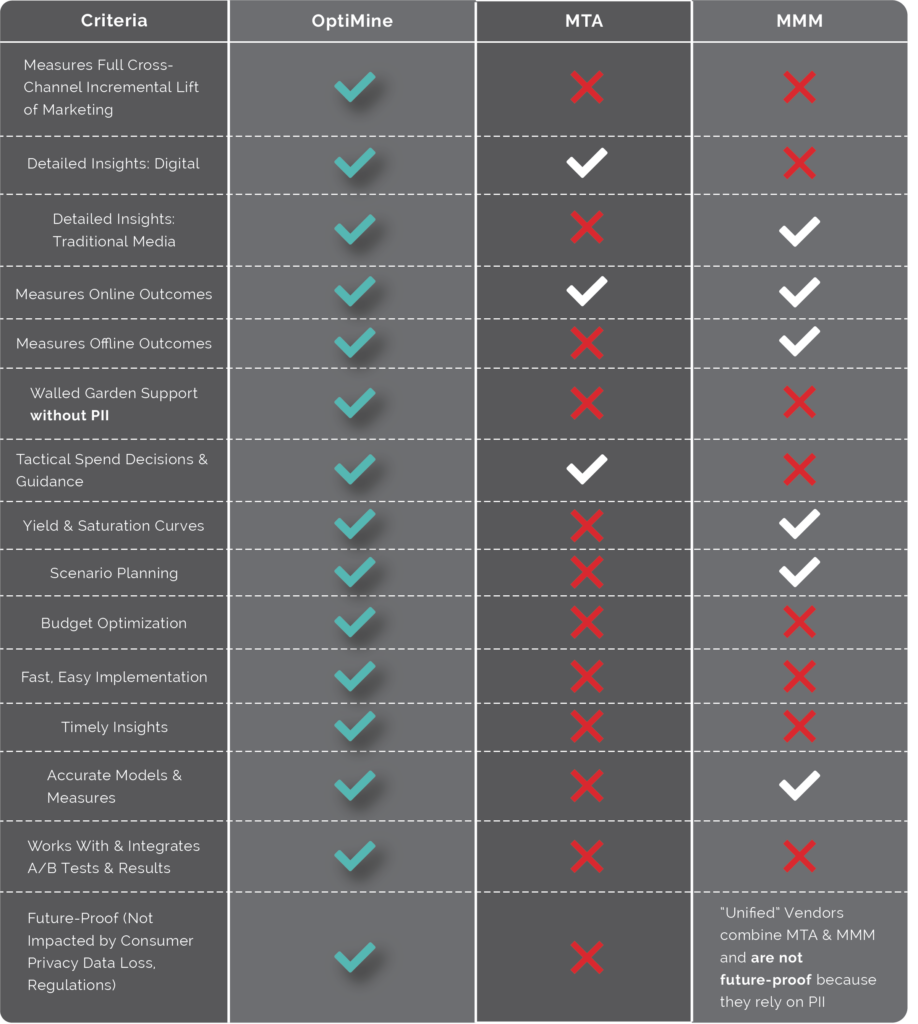Contents
- What is Marketing/Media Mix Modeling (MMM)?
- How Marketing/Media Mix Modeling Works
- Advantages of Marketing/Media Mix Modeling
- Disadvantages of Marketing/Media Mix Modeling
- An Example of Marketing/Media Mix Modeling
- When to use Marketing/Media Mix Modeling
- Comparing OptiMine with MTA and Traditional MMM
- Marketing/Media Mix Modeling Tools
Guide to Marketing/Media Mix Modeling (MMM)
06/23/2020
If you’ve been watching the ad tracking and cookie demise news over the last few years, you’ll know it is becoming increasingly obvious that ad tracking is becoming more and more difficult, and that older methods for marketing measurement (such as Multi-Touch Attribution) relying on various ad tracking mechanisms are no longer useful. As time treks on, more protocols are being put into place to limit ad tracking.
However, user acquisition and measurement of advertising performance remains just as critical to success as it has always been—but the question now is about what form that function takes as measurement strategies shift away from consumer tracking. The answer: Media Mix Modeling (MMM). This type of modeling has been around for decades helping major brands measure large brand campaigns. Now, because of advanced software and automation, any brand can take advantage of this advanced analytic approach—even for mobile and in-app advertising.
What is Marketing/Media Mix Modeling (MMM)?
Marketing Mix Modeling, also known as Media Mix Modeling (or MMM for short) is a statistical method for building predictive models using multi-variate regression. The models evaluate media impressions and spend, non-marketing factors such as economic conditions or other elements that move business performance more broadly, and converting activity over time to measure the contributions of each of these elements towards conversions (sales, traffic, customer acquisitions, engagement, branding impacts, etc.). These measures then allow the marketer to understand potential outcomes by evaluating different marketing investment levels or other scenarios.
Marketing Mix Modeling has been used by large brands for many decades and was a primary means to understand how large traditional media campaigns (TV, Print, Radio) impact sales activity. MMM can be highly accurate and is a well-proven approach to marketing measurement.
How Marketing/Media Mix Modeling Works
MMM uses a time series modeling approach to examine whether changes in media reach (impressions, GRPs, etc.) over time correlate with conversion changes.
Advantages of Marketing/Media Mix Modeling

As mentioned, MMM has several advantages and benefits to the marketing organization:
- Accuracy
- Complete coverage of digital and traditional marketing channels
- Complete measurement of online and offline conversion outcomes
- The ability to estimate and measure media saturation and yield levels, which allows marketers the ability to pinpoint optimal investment levels
- Advanced MMM approaches also provide scenario planning and budget optimization capabilities to allow marketers to run simulations to forecast different outcomes
- MMM uses no PII
Disadvantages of Marketing/Media Mix Modeling

Even given the many advantages of MMM, traditional Marketing Mix Modeling solutions have some significant drawbacks and considerations for brands. Most of these weaknesses are a result of the fact that the MMM models are produced and delivered by manual methods requiring expensive, deeply experienced (and expensive) consultants:
- Expensive: there is a reason that only the largest brands in the world have used MMM- they can afford to cover these significant expenses as part of their large marketing and analytics budgets.
- Slow: because traditional MMM is a manual consulting exercise, building models or changing them over time takes a significant amount of time. It is common for brands using MMM to get the measures many months after the period being measured.
- Inflexible: new data, business questions, KPIs and outcomes are all part of the real-world facing marketers and brands. And all of these present challenges to traditional Media Mix Models because they all represent more manual changes, tasks, time and new costs. As a result, many MMM deployments are highly static and don’t change much because brands don’t have the resources to evolve the models over time.
- Not Actionable: nearly all Marketing Mix Models use highly summarized data typically rolled up by week or by month. And because the models are built using highly manual efforts, it is nearly impossible to get deeply detailed guidance from MMM measures. As such, teams get very high-level recommendations that are frequently difficult to execute at any level of precision. This is an even bigger issue within digital marketing channels that frequently have hundreds or thousands of different campaigns, targeting elements and execution approaches, all with very different performance characteristics. These important nuances are missed completely with traditional MMM models.
An Example of Marketing/Media Mix Modeling
For a simple example of MMM, consider the case where a brand places a billboard next to the highway. The model can now examine sales before the billboard and now whether sales have increased with the placement of the new billboard. If the brand takes the billboard down and sales drop accordingly, puts the billboard back up and sales increase again, the brand can be reasonably confident that the billboard is impacting sales positively. Well designed Marketing Mix Models also account for other factors besides media. In this case, the brand may also try to account for other factors such as the weather, promotions, seasonality, holidays and day-of-week effects before confidently concluding that the media (the billboard) is the reason for changes in sales versus these other factors that may be playing a part in sales changes over time.
While this method is probabilistic in nature, and does not attempt to match media consumption at individual customer levels using PII, it can provide a very accurate measure of the incremental contribution of marketing investments on many different types of outcomes. Also, Marketing Mix Modeling has a major advantage over other measurement approaches such as Multi-Touch Attribution in that it can measure both digital and traditional media as well as online and offline conversion outcomes.
When to use Marketing/Media Mix Modeling
Marketing Mix Modeling is best used when a brand wants to understand and measure the incremental contributions of their marketing, and in particular, when the brand has a mix of digital and traditional marketing channels. With a more complex media mix, MMM is an ideal fit and can handle this kind of marketing complexity, and most importantly can help the brand get more performance and efficiency from their marketing budget. And with advances in AI and high-speed computing, MMM is no longer a tool just for larger global enterprises but is now an option for all brands that need advanced marketing measurement and optimization.
Comparing OptiMine with MTA and Traditional MMM
For a comparison of OptiMine’s capabilities alongside those of MTA and Traditional MMM, reference the chart below:

Marketing/Media Mix Modeling Tools
Having the right Marketing Mix Modeling (MMM) tools makes everything easier. Check out our “Intent” product to see how OptiMine’s MMM tools can help you & your brand be successful, here.

